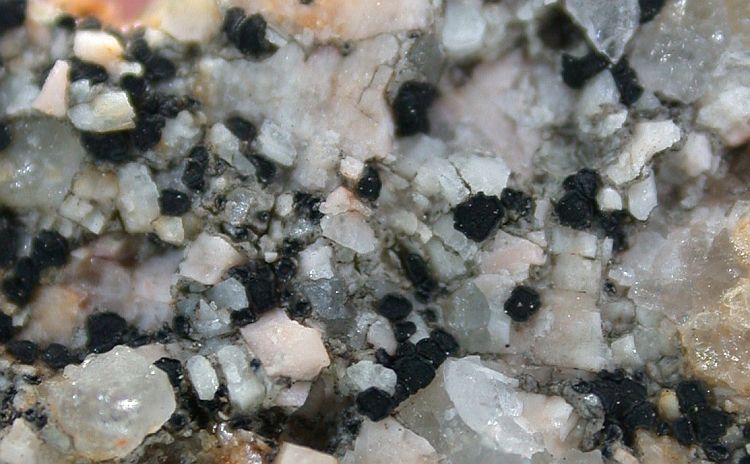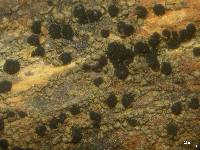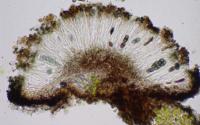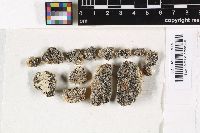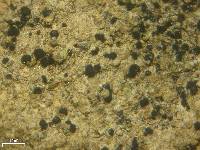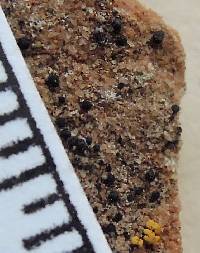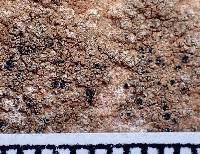
- Home
- Search
- Images
- Species Checklists
- US States: O-Z >
- US National Parks
- Central America
- South America
- US National Parks
- Southern Subpolar Region
|
|
|
|
Family: Caliciaceae
[Lecidea abstracta Nyl.] |
Nash, T.H., Ryan, B.D., Gries, C., Bungartz, F., (eds.) 2007. Lichen Flora of the Greater Sonoran Desert Region. Vol 3. Please note the publication by Giralt, M., F. Bungartz & J. A. Elix 2011: The identity of Buellia sequax. Mycological Progress 10(1): 115-119. The description below (originally published for B. sequax) applies to Buellia abstracta: Thallus: crustose, thin, discontinuous, ±endosubstratic (chasmolithic); prothallus: absent surface: usually pale brown, rarely pale gray, dull, slightly roughened, epruinose, phenocorticate, esorediate medulla: white, lacking calcium oxalate (H2SO4-) Apothecia: lecideine; (0.2-)0.3-0.4(-0.7) mm in diam., soon adnate to sessile margin: black, thin, rarely persistent, soon excluded with age disc: black, epruinose, plane, usually becoming convex with age proper exciple: narrow, poorly differentiated, aethalea-type, inner excipular hyphae narrow, hyaline, prosoplectenchymatous (textura oblita), often reduced, similar in structure and orientation to the paraphyses, transient with the deep reddish brown hypothecium (leptoclinoides-brown, textura intricata), outer excipular hyphae parallel, moderately swollen (textura oblita) strongly carbonized with various amounts of a brown pigment (cf. elachista-brown, HNO3-) epihymenium: brown, pigmentation continuous with the outer exciple (HNO3-) hymenium: hyaline, not inspersed with oil droplets; paraphyses: simple to moderately branched, apically swollen, with a brown pigment cap (cf. elachista-brown) asci: clavate, Bacidia-type, 8-spored ascospores: soon brown, 1-septate, distinctly narrowly-oblong, becoming ellipsoid with age, with obtuse ends, not or rarely curved, (10-)10.7-[11.7]-12.8(-14) x (3-)3.8-[4.6]-5.4(-6) µm (n=50); proper septum: narrow, not thickening during spore ontogeny (Buellia-type); ornamentation: microrugulate (absent in young spores, becoming visible only in mature spores, best seen in DIC) Pycnidia: rare, globose, unilocular; ontogeny similar to the Umbilicaria-type conidiogenous cells: mostly terminal, rarely also intercalary (cf. conidiophore-type V) conidia: bacilliform, 2-4 x 1-1.5 µm (n=50) Spot tests: all negative (very rarely forming orange needle-shaped crystals with K if observed with the compound scope) fluorescence: UV- (dark) iodine reaction: medulla non-amyloid. Substrate and ecology: chasmolithic (i.e., forming inconspicuous, poorly delimited granules hidden among the mineral grains of the substrate), on/in siliceous mineral-poor rock (generally HCl-), from coastal up to subalpine localities. World distribution: widely distributed throughout the North American Southwest and Mediterranean Europe. Sonoran distribution: very common in Arizona, southern California, Baja California, Baja California Sur, and Sonora. Notes: In the Sonoran Flora, the name Buellia sequax was erroneously applied to Buellia abstracta to which this description here applies. Buellia abstracta is the most common Sonoran species with chasmolithic growth, i.e., a thallus mostly hidden between the mineral grains of the substrate. Characteristic are also the narrow ascospores. Because of this growth specimens that clearly belong to Buellia abstracta have frequently been misidentified as B. vilis. Specimens of B. abstracta with an unusually well developed thallus are sometimes superficially similar to B. prospersa and diagnostic differences have been discussed under that species. The species appears very common but is often overlooked. |
|
|
|

